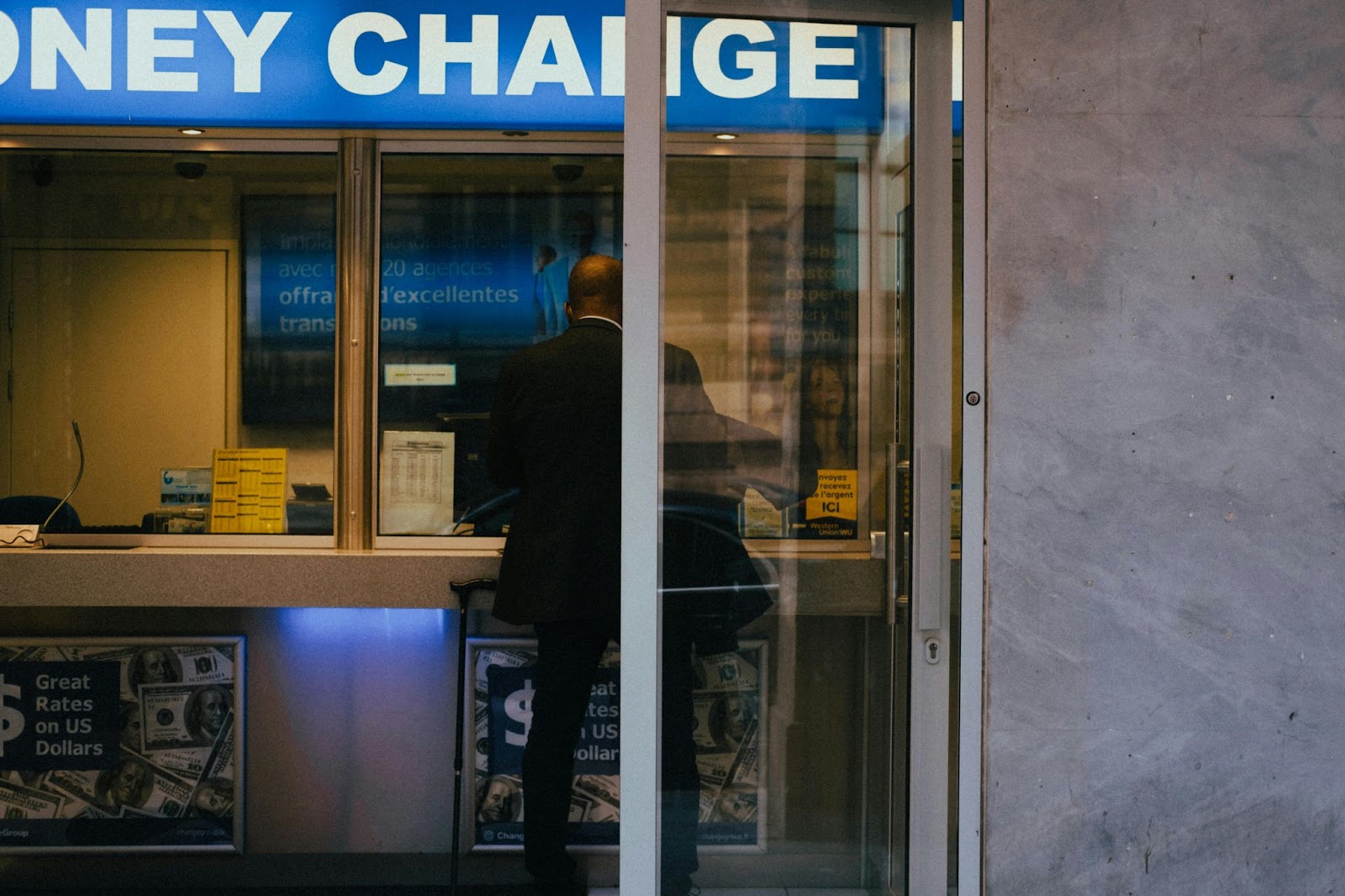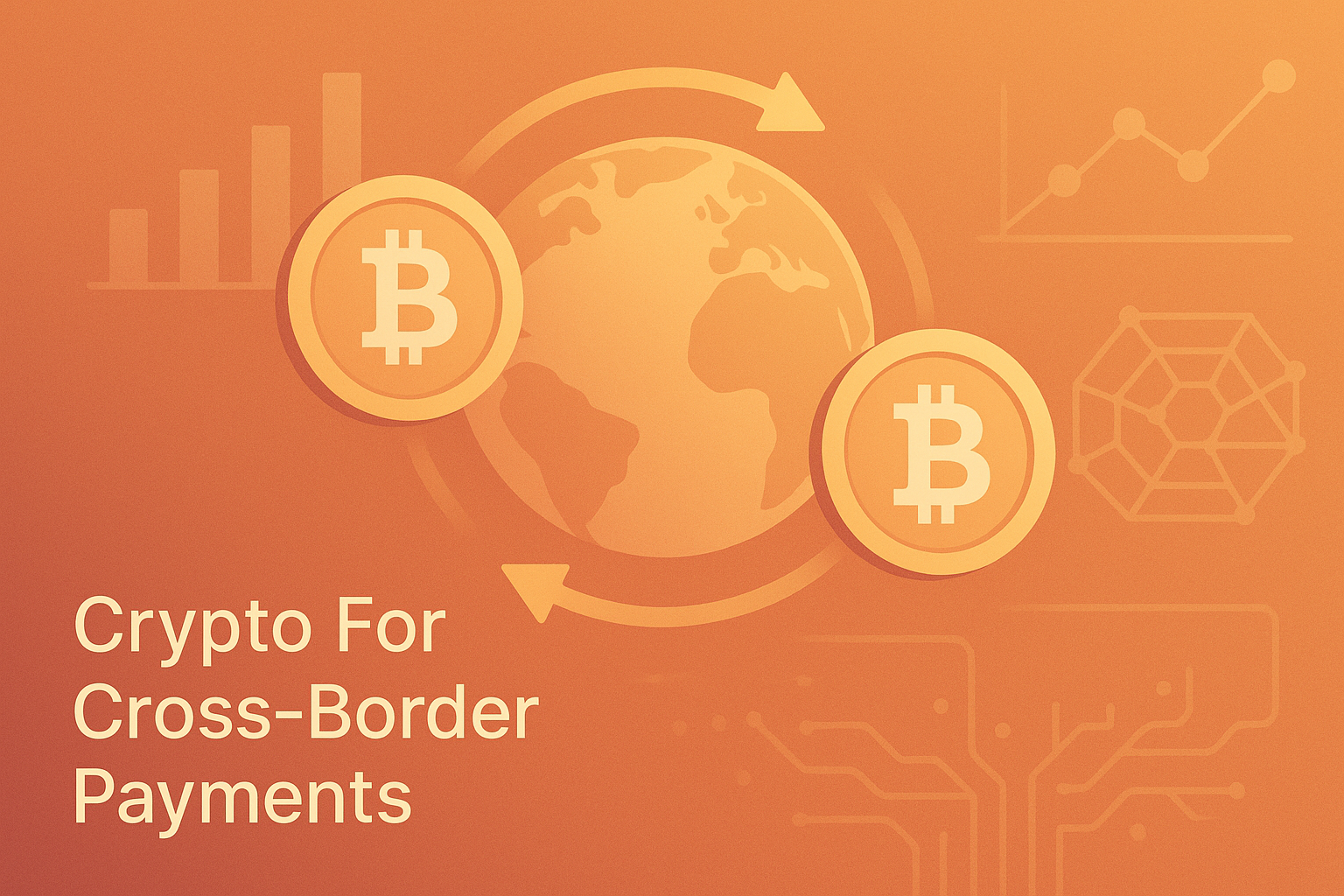Here’s how crypto for cross-border payments can revolutionize international transfers.
Sending money across borders shouldn’t feel like sending a message by pigeon. Yet with traditional banking systems, it often does. You wait for days. You lose a chunk to hidden fees. And cross your fingers hoping the transfer actually goes through. Whether you’re a freelancer getting paid from abroad, a business owner dealing with overseas vendors, or someone just sending money to family back home, you’ve probably faced these headaches.
Now, there’s a better way. Enter crypto.
Crypto for cross-border payments is changing the game. It’s faster, cheaper, and doesn’t rely on middlemen or banking hours. Imagine sending money from London to Lagos in seconds. Without banks nibbling away at your funds or delays holding things up. It’s one of the best ways how businesses can use crypto in the real world.
After all, blockchain technology has turned what used to be a complex, frustrating process into something nearly instant and borderless. And we’re just getting started.
So, let’s explore how crypto is shaking up international payments. Dive in to see which coins work best, real-life use cases, and the challenges ahead.
What’s the problem with traditional cross-border payments?

Image on Pexels
Before we jump into how crypto is transforming global transfers, it’s important to understand the issues people face with the old system. Traditional cross-border payments are dominated by banks and services like SWIFT or Western Union. Unsurprisingly, they are riddled with issues that keep customers on their toes.
So, here’s what makes them such a pain.
1. Slow and outdated processing times
Ever tried sending money overseas on a Friday evening? It often takes 3 to 5 business days for funds to move across countries. Traditional banks rely on legacy systems that were never built for speed. And let’s not even talk about weekends or holidays when transfers come to a halt entirely.
2. Excessive fees and hidden charges
Between sender fees, currency conversion charges, intermediary bank deductions, and receiver-side costs, the total fee can eat up a good chunk of your transfer. Sometimes 10% of it or more. These charges hit hardest for those sending small amounts. Especially migrant workers supporting families abroad.
3. Lack of transparency
Once the money is “in transit,” you’re left in the dark. Where is it? Who’s holding it? When will it land? Traditional systems lack real-time tracking. This lack of transparency creates anxiety during emergencies or large transactions.
4. Limited access in developing regions
Many people in lower-income or remote regions don’t have access to formal banking services. That means they’re shut out of international financial flows. Cross-border payments, in this case, become an uphill battle. It’s filled with tremendous paperwork, long queues, and unreliable delivery channels.
5. Dependency on intermediaries
Most international transactions pass through multiple banks before reaching the recipient. Each stop adds more time, more cost, and more room for error. These middlemen aren’t just unnecessary. They’re expensive.
Now, it’s time for a new system
The world is becoming more connected. Yet moving money globally is still stuck in the past. That’s where crypto for cross-border payments comes in. They cut out the middle layers, reduce costs, and unlock faster, more transparent transfers for everyone.
How crypto for cross-border payments solves the problem
As we discussed earlier, traditional money transfers are slow, expensive, and painfully outdated. But crypto flips the script. Thanks to blockchain technology, sending money across the globe no longer needs to involve a maze of banks and hidden fees.
Let’s break down exactly how crypto for cross-border payments is making life easier for individuals, businesses, and entire economies.
1. Peer-to-Peer transactions
One of the biggest breakthroughs in crypto is peer-to-peer (P2P) technology. When you send Bitcoin, USDT, or any other cryptocurrency, it goes straight from your wallet to the recipient’s. No banks, brokers, or third-party processors involved.
This direct exchange cuts out all the extra steps and people who usually slow things down and drive costs up. Thus the funds reach the other side faster and with fewer hurdles.
2. Fast global transfers on the blockchain
With blockchain, there’s no waiting around for “business days” to pass. Most crypto transactions confirm in just minutes. Some even in seconds, depending on the network.
Compare that to traditional transfers, which can drag on for days. Networks like Solana, Polygon, and Lightning (for Bitcoin) are pushing the boundaries of speed, making cross-border transactions nearly instant and extremely efficient. This is a game-changer for urgent transfers or time-sensitive payments.
3. Significantly lower fees
Bank fees, foreign exchange markups, and intermediary cuts can seriously eat into the money you’re trying to send. But crypto changes that.
Many crypto transfers cost just a few cents. Especially when using low-fee networks like TRON (for USDT), Stellar, or Layer-2 solutions. Even Ethereum, known for higher gas fees, is becoming more efficient with upgrades and scaling solutions.
For migrant workers, small business owners, or anyone regularly sending funds abroad, this savings is more than just convenience. It’s financial empowerment.
4. Transparent, trackable, and irreversible transactions
One major issue with traditional transfers is the lack of visibility. You send money, and then… silence. With crypto, every transaction is recorded on a public blockchain. That means anyone can view its status in real time using a block explorer.
You know when it was sent, when it’s confirmed, and where it’s headed. Total transparency.
Plus, crypto transactions are irreversible. Once confirmed, no one can tamper with them. There are no chargebacks or third parties freezing your funds unexpectedly. This builds trust, especially for global freelance work and international business deals.
5. Availability… 24/7
Banks have office hours. Crypto doesn’t.
Crypto networks run 24/7, 365 days a year. You can send or receive funds any time. Late at night, on weekends, or during global holidays. This uninterrupted access is particularly valuable for remote teams working across time zones. And even for families needing to send emergency money instantly.
You’re no longer at the mercy of someone else’s schedule.
The big picture
Together, all these features make crypto for cross-border payments a serious alternative to the legacy financial system. It’s not just faster or cheaper. It’s fundamentally more aligned with how the modern world moves and connects.
What are some use cases of crypto in cross-border transfers?

Image on Freepik
The benefits of crypto aren’t just theory. They’re already being used around the world. From migrant workers to multinational companies, everyone’s exploring them. People are discovering faster, cheaper, and smarter ways to move money across borders.
Let’s explore how crypto for cross-border payments is making a real impact in different industries and communities.
1. Blockchain remittances
Millions of migrant workers send money back to their families every month. But with traditional remittance services, they often lose a significant portion of their hard-earned income to fees and currency conversion charges.
Blockchain remittances can be a more efficient alternative. With stablecoins like USDT or USDC, workers can send money instantly with minimal fees. And their families can receive it directly on a mobile wallet. In countries like Nigeria, the Philippines, and El Salvador, crypto is increasingly being used to avoid banks altogether. Especially where financial infrastructure is limited or unreliable.
Not only is it faster and cheaper. But it also gives families better control over when and how they access their money.
2. Freelancers and remote workers
The freelance economy is booming. And crypto is becoming a favorite payment option for international clients and workers alike. After all, traditional payment platforms like PayPal or wire transfers can be slow and expensive. They’re even unavailable in some regions.
Crypto eliminates those barriers. A developer in Argentina or a translator in Kenya can now get paid in USDC or Bitcoin within minutes. No bank required. Platforms like Bitwage and Deel even offer crypto payroll options for remote teams.
This gives freelancers more flexibility. They get faster access to earnings and less dependence on currency fluctuations or local banking policies.
3. Small businesses and startups
Startups and SMEs working with global partners often face challenges with cross-border B2B payments. Banks take time, demand a mountain of paperwork, and charge hefty fees.
With crypto, payments to international vendors or service providers can be made instantly. No intermediaries. No waiting. Stablecoins are particularly useful here. They help businesses avoid crypto volatility while enjoying all the speed and cost benefits of blockchain-based transactions.
Plus, smart contracts allow for automated and secure payments based on pre-agreed conditions. That’s a huge win for managing service agreements and recurring payments.
4. Charity and aid transfers
When it comes to humanitarian aid, transparency and speed are critical. Unfortunately, traditional systems can be slow, bureaucratic, and opaque. With large chunks of donations lost in administrative layers.
Crypto provides a transparent and direct way to distribute aid. Donors can see exactly where their funds go. And recipients can receive help instantly. Even in places without formal banks. Nonprofits like Save the Children and the Red Cross have experimented with crypto-based donations.
In crisis zones or regions facing inflation, access to a stable digital currency can be life-changing. It ensures the right people get the right support, at the right time.
5. Corporate treasury use
Larger companies are also waking up to the strategic benefits of crypto. By holding digital assets in their treasury, they can hedge against local currency risk. This also helps in moving capital across borders quickly. Thus accessing global liquidity on demand.
Some firms use crypto to fund operations in countries. Especially those with strict capital controls or hyperinflation. Others use it to simplify international settlements between global branches.
This corporate use of crypto for cross-border payments is still in its early stages. But it’s growing fast. Especially among tech-forward companies looking for more agile financial tools.
Real value. Real use.
From individuals to enterprises, crypto is not just an alternative. It’s often the better choice for moving money globally. Crypto for cross-border payments is bringing inclusion, transparency, and speed to a space that desperately needs it.
What are the most popular crypto for cross-border payments?

Photo by Worldspectrum
When it comes to sending money across borders, not all cryptocurrencies perform equally. While blockchain technology powers them all, some coins are better suited than the others. And so, choosing the right cryptocurrency can make a huge difference. Especially in terms of cost, confirmation time, and reliability.
Let’s break down 10 of the most popular cryptocurrencies used for international transfers. Moreover, explore how they stack up when it comes to crypto for cross-border payments.
1. Bitcoin (BTC)
Bitcoin may be the oldest and most recognized cryptocurrency. But it’s not always the fastest or cheapest option for sending money abroad. That said, it still sees widespread use. Especially for large-value transfers or in countries with unstable currencies.
- Pros: Global adoption, high liquidity, strong security.
- Cons: Slower transaction speeds (10 minutes per block), high fees during network congestion.
- Best For: High-value transfers, long-term store of value.
That said, Bitcoin is becoming more viable for smaller, real-time transactions. Thanks to tools like the Lightning Network. And that could boost its role in cross-border payments in the future.
2. Ethereum (ETH)
Ethereum is the backbone of decentralized finance (DeFi). It powers some of the Top DeFi Projects and supports a massive ecosystem of dApps. While ETH itself isn’t always the cheapest or fastest, it powers many stablecoins and tokens used in cross-border transfers.
- Pros: Widely supported, DeFi-friendly, strong network.
- Cons: High gas fees (though improving with scaling solutions).
- Best For: Payments involving smart contracts or DeFi services.
Layer-2 solutions like Arbitrum, Optimism, and zkSync are helping Ethereum scale. Thus making it increasingly efficient for global money movement.
3. Tether (USDT)
Tether is a USD-pegged stablecoin. And it has become a global favorite for remittances and international B2B transfers. It’s supported on multiple networks like Ethereum, TRON, Solana, and Polygon. Therefore, allowing users to choose the fastest and cheapest route.
- Pros: Price-stable, widely accepted, low fees on networks like TRON.
- Cons: Centralized issuer, regulatory scrutiny.
- Best For: Sending and receiving dollar-equivalent funds instantly.
A crypto for cross-border payments that offers stability. But, without the hassle of bank fees. That’s USDT.
4. USD Coin (USDC)
USDC is Tether’s main competitor but with a greater focus on transparency and compliance. Backed 1:1 with USD reserves, it’s favored by businesses and institutions for cross-border settlements.
- Pros: Fully backed, audited reserves, available on multiple blockchains.
- Cons: Fewer listings in some regions than USDT.
- Best For: Business payments, compliant transfers, DeFi use cases.
USDC is gaining serious ground. Especially for regulated financial apps and international corporate payments.
5. Ripple (XRP)
Ripple’s XRP token was purpose-built for fast and affordable international money transfers. It’s especially known for its partnerships with financial institutions and banks across the globe.
- Pros: Super-fast transactions (3–5 seconds), low fees.
- Cons: Legal uncertainty due to past SEC litigation.
- Best For: B2B and bank-to-bank cross-border settlements.
Despite regulatory drama in the U.S., XRP remains widely used globally for frictionless, cross-border value exchange.
6. Stellar Lumens (XLM)
Stellar was created as a fork of Ripple and shares a similar mission: global financial access. Its focus is on low-cost payments and cross-border transfers, especially in underserved regions.
- Pros: Fast, affordable, ideal for micro-transfers.
- Cons: Less mainstream adoption than XRP.
- Best For: Micro remittances, developing-market transfers, NGOs.
Stellar has partnered with MoneyGram and other major players to bring real-world utility to blockchain-based remittances.
7. TRON (TRX)
While TRON’s native token (TRX) is less used for payments, its blockchain is extremely popular for sending USDT. So much so that USDT on Tron has surpassed $80 billion in volume. In fact, most global Tether transfers now happen on the TRON network due to ultra-low fees and quick confirmations.
- Pros: Low fees, fast transactions.
- Cons: Centralization concerns, mainly used for USDT.
- Best For: Stablecoin transfers via USDT.
If you’re looking to send stablecoins on a budget, TRON is your best bet.
8. Litecoin (LTC)
Litecoin is one of the earliest Bitcoin alternatives. It is optimized for payments. With 4x faster block times and lower fees, it’s been adopted by payment processors around the world.
- Pros: Faster than BTC, low transaction fees.
- Cons: Less ecosystem development.
- Best For: Low-cost, fast personal payments.
Litecoin’s simplicity and stability make it a practical choice for direct peer-to-peer transfers. Especially for crypto-savvy users.
9. Dash (DASH)
Dash focuses heavily on real-world payments and has gained traction in Latin America and Africa. Its InstantSend feature allows near-instant confirmations, ideal for retail and small-scale transfers.
- Pros: Instant payments, strong community use in emerging markets.
- Cons: Lower overall adoption compared to major coins.
- Best For: Day-to-day remittances, retail payments, local commerce.
Dash isn’t as popular globally as it once was. But in certain regions, it’s a leading force in the crypto-powered money movement.
10. Celo (CELO)
Celo is designed specifically for mobile devices and emerging economies. With its own USD stablecoin (cUSD), it allows users to send and receive payments using phone numbers. No complicated wallet addresses required.
- Pros: Mobile-native, low fees, easy onboarding.
- Cons: Still growing adoption.
- Best For: Financial inclusion, mobile remittances, aid distribution.
Celo’s focus on accessibility makes it ideal for humanitarian payments, rural remittances, and onboarding first-time crypto users.
How to choose the right crypto for cross-border payments
With so many options available, how do you decide which cryptocurrency is right for your needs? Consider the following:
- Speed vs Cost: TRON and Stellar are fast and cheap. While Ethereum may be more secure but pricier.
- Stability: Use stablecoins like USDT or USDC to avoid crypto volatility.
- Accessibility: Pick a coin or network that both you and your recipient can easily use.
- Regulation and Compliance: For businesses, choosing a regulated token like USDC may be necessary.
Remember, many platforms now offer multi-chain support. That means you can pick your coin and your network based on what works best for the moment.
Overall, the variety of digital currencies being used for global payments is growing fast. Whether you’re making personal transfers, running a business, or delivering aid, there’s a cryptocurrency designed to meet your needs.
And as adoption spreads and technology continues to improve, crypto for cross-border payments will only become more efficient, accessible, and trusted.
What are some challenges and limitations of crypto for cross-border payments?

Photo by Behnam Norouzi on Unsplash
While crypto has opened up a new world of possibilities for global money movement, it’s not without its challenges. As promising as it is, crypto for cross-border payments still faces real-world limitations that slow down adoption. Especially in countries that need it most.
Let’s break down the key hurdles standing in the way of a fully decentralized global payments system.
1. Regulatory uncertainty and KYC/AML laws
One of the biggest roadblocks for crypto’s global use is unclear or inconsistent regulation.
Governments around the world are still figuring out how to classify and control cryptocurrencies. In some countries, crypto is embraced. In others, it’s restricted, heavily taxed, or even banned outright. This makes it difficult for businesses and financial institutions to adopt crypto without fear of legal pushback.
Moreover, international transactions often require KYC (Know Your Customer) and AML (Anti-Money Laundering) compliance. These are the policies designed to prevent fraud, money laundering, and terrorist financing. But crypto was built for privacy and decentralization. This creates tension between innovation and regulation.
While many crypto exchanges and wallets have started enforcing KYC, this raises concerns about user privacy and access, particularly for unbanked populations who lack formal IDs.
2. Volatility in crypto prices
One of the first things people associate with crypto is volatility. And for good reason.
Coins like Bitcoin and Ethereum can swing wildly in value within hours. That kind of unpredictability is fine for trading or investing, but it’s a big issue when you’re trying to send money across borders.
Imagine sending $500 worth of ETH, only for it to drop to $430 by the time it arrives. That’s not ideal. Especially for families relying on remittances or businesses making payroll.
Stablecoins help solve this issue, offering a digital currency pegged to traditional assets like the US dollar. But even stablecoins come with concerns around trust, regulation, and platform risk. Particularly if the issuing company is poorly managed or under investigation.
3. Scams, mistakes, and irreversible transactions
Crypto is powerful. But also unforgiving.
If you mistype a wallet address, your funds are gone. Permanently. There’s no customer service hotline or “undo” button. This is especially risky for new users who aren’t familiar with crypto interfaces or best practices.
Worse, the crypto world is still plagued by scams, phishing attacks, and fake platforms. From suspicious airdrops to social engineering tricks, there are countless ways users can lose their funds.
This fear of error or fraud keeps many people away from crypto. Even if it offers better speed and lower costs than traditional systems. Thus, for crypto for cross-border payments to go mainstream, platforms must become safer, simpler, and more user-friendly. Better education, design, and built-in protections are key.
4. Limited crypto literacy and infrastructure in some regions
Access to crypto isn’t just about downloading a wallet. It also depends on infrastructure and understanding.
In many developing countries, people don’t have access to smartphones, reliable internet, or financial education. Even if the tools are available, users may not feel confident enough to use them. Terms like “gas fees,” “block confirmations,” or “private keys” can feel alien to someone unfamiliar with digital finance.
Moreover, local governments may block crypto exchanges or apps. Thus making access difficult or illegal. And without proper on-ramps (like fiat-to-crypto platforms), people can’t easily convert their local currency into crypto or cash out their funds.
Without education and support, even the best blockchain tools won’t reach the people who could benefit most.
The road ahead
Despite these challenges, the growth of crypto for cross-border payments hasn’t slowed. It’s just evolving. Developers, policymakers, and innovators are working together to close the gaps between potential and practicality.
From clearer regulations to better-designed apps and global education efforts, progress is being made. But for crypto to truly become the global standard for sending money across borders, it must be accessible, understandable, and trustworthy. For everyone, everywhere.
How’s the future outlook of crypto-based cross-border payments?

Image on Freepik
As blockchain adoption spreads, the way we move money across borders is going through a complete transformation. While crypto has already made waves, the future promises even more radical change. It blends innovation from the private and public sectors, simplifying user experiences, and making global transactions more efficient and inclusive.
Let’s take a closer look at what lies ahead for crypto for cross-border payments and the evolving financial ecosystem around it.
1. CBDCs vs Crypto: Coexistence or competition?
Central Bank Digital Currencies (CBDCs) are government-backed digital versions of fiat currency. Countries like China (with the digital yuan), the UK (Digital Pound), and several others are actively piloting or developing CBDCs.
While CBDCs promise faster domestic and international payments, they’re centralized. The very opposite of what most cryptocurrencies aim to be.
So, will CBDCs replace crypto? Not exactly.
They may coexist. CBDCs might be used for regulated, large-scale payments, while decentralized crypto continues to empower peer-to-peer transfers, especially where people don’t trust local governments or banks. Stablecoins could bridge the gap, functioning alongside both systems.
In short, we’re moving toward a mixed financial future. With both public and private digital currencies playing unique roles.
2. Governments warming up to blockchain-based remittances
Even skeptical governments are starting to recognize blockchain’s potential. Especially in remittances, where speed and traceability are major pain points.
Some countries are exploring blockchain-based remittance platforms that allow citizens abroad to send money home instantly and transparently. El Salvador, for example, adopted Bitcoin as legal tender and uses it for remittances. Other nations, especially in Latin America, Africa, and Southeast Asia, are exploring similar models.
This signals a major shift: Instead of banning crypto, governments are starting to harness its advantages to serve their own populations. Cutting down fees, increasing transparency, and speeding up fund delivery.
3. Integration of crypto into banking and payment apps
One of the clearest signs of crypto’s future in cross-border payments is its quiet integration into mainstream financial apps.
Companies like PayPal, Revolut, and Cash App already allow users to buy, hold, and send crypto. Some banks are now experimenting with crypto custody and on/off-ramps. As these tools mature, users may soon be able to send USDC or BTC internationally. Without even realizing they’re using crypto.
This “crypto under the hood” approach could massively accelerate adoption. For most users, it’s not about ideology. Rather, it’s about convenience. If crypto gets embedded into familiar interfaces, more people will use it by default.
4. Web3 wallets and identity linking for seamless transfers
One challenge with crypto is usability. Especially when it comes to remembering long wallet addresses or dealing with public/private keys. But Web3 wallets are evolving to fix that.
In the near future, sending money could be as easy as typing someone’s name or phone number. Wallets like Coinbase Wallet, Unstoppable Domains, and ENS (Ethereum Name Service) are working on simplified, human-readable usernames. Some are also exploring decentralized identity (DID) systems. These will let users link wallets to verified identities or profiles.
These advancements will make crypto for cross-border payments not just powerful, but effortless. Even for first-time users.
5. Growth of Layer-2 solutions
Scalability is one of crypto’s biggest hurdles. But that’s where Layer-2 solutions come in.
Protocols like the Lightning Network (built on top of Bitcoin) and zk-Rollups (used in the Ethereum ecosystem) are designed to handle thousands of transactions per second while reducing fees and congestion.
Here’s what this means for the future:
- Lightning Network: Enables instant, near-zero fee BTC payments. That’s ideal for remittances and micro-payments.
- zk-Rollups & Optimistic Rollups: Offload computation and storage from Ethereum, dramatically improving transaction speed and cost-efficiency.
These technologies will make blockchain infrastructure fast enough to rival traditional payment rails. Thus, unlocking new use cases and driving mass adoption.
Looking forward
The next chapter of crypto for cross-border payments won’t be about replacing banks. It’ll be about reinventing how global value moves. Faster networks, smarter wallets, cooperative governments, and integrated platforms are coming together to create a seamless experience for everyone. From tech-savvy users to people just discovering digital finance.
The pieces are falling into place. The question isn’t if this transformation will happen. Rather, it is: How fast will it happen?
How to send crypto across borders

Image on Freepik
Sending money across borders with crypto might sound technical, but it’s actually simple once you understand the steps. This guide will walk you through the process. No tech degree required.
Here’s how to send crypto for cross-border payments safely and efficiently:
Step 1: Choose the right coin for the job
Not all cryptocurrencies are ideal for global transfers. Some are fast but volatile (like ETH), while others are stable and widely used (like USDT or USDC). If you’re looking for stability, go with a stablecoin like:
- USDT (Tether) – Available on multiple blockchains, widely accepted.
- USDC – Transparent and trusted, good for compliant transactions.
- DAI – Decentralized and backed by crypto collateral.
These coins are pegged to the U.S. dollar, meaning their value doesn’t swing like traditional cryptocurrencies. That makes them perfect for sending fixed amounts internationally without worrying about price changes.
Step 2: Set up a secure wallet
To send and receive crypto, both you and the recipient need a crypto wallet. Think of it like a digital bank account. But you control it. Popular and user-friendly wallets include:
- MetaMask (great for Ethereum-based tokens)
- Trust Wallet (supports many chains, including TRON and BNB)
- Exodus (great for beginners)
- Coinbase Wallet (different from Coinbase exchange, supports self-custody)
Download the app, write down your seed phrase (this is crucial!), and never share it with anyone. It’s your key to the wallet and your funds.
Step 3: Pick the right blockchain network
Here’s where many people get tripped up. You must choose the correct network when sending crypto. Most stablecoins like USDT and USDC exist on multiple blockchains. For example:
- TRC-20 (TRON Network): Very low fees, fast. Ideal for budget-friendly transfers.
- ERC-20 (Ethereum Network): Widely supported, but has higher gas fees.
- BEP-20 (BNB Smart Chain): Cheap and fast, growing adoption.
Make sure both you and your recipient use the same network. Otherwise, the funds could be lost or stuck.
Pro tip: If saving on fees is a priority, go with TRC-20 USDT on Trust Wallet.
Step 4: Double-check the recipient’s address
Always copy and paste the recipient’s wallet address. And double-check it. Even one wrong letter or number means the funds could be sent to the wrong person… or lost forever. To be safe:
- Ask the recipient to send their address in writing (not a screenshot).
- Paste the address into your wallet carefully.
- Verify the network matches (e.g., TRC-20 address for TRC-20 USDT).
Some wallets even let you scan a QR code to avoid errors altogether.
Step 5: Send the crypto and track the transaction
Once everything looks correct, hit Send and confirm the transaction.
Most wallets will show a pending status until the network confirms the transfer. You can also track it using a block explorer. It is a tool that lets you follow the transaction on the blockchain. Use these explorers depending on the network:
- TRON (TRC-20): Tronscan.org
- Ethereum (ERC-20): Etherscan.io
- BNB Chain (BEP-20): BscScan.com
Just paste the transaction ID (TXID) to see when it’s confirmed.
Step 6: Optionally cash out to local currency
If the recipient wants to convert the crypto into local fiat currency (like PKR, INR, NGN, or PHP), they’ll need a trusted exchange or peer-to-peer platform. Popular options include:
- Binance (global, with P2P cash-out)
- KuCoin (supports multiple fiat gateways)
- LocalBitcoins or Paxful (for cash deals)
- Remitano, OKX, or Yellow Card (region-specific options)
Make sure the platform supports the crypto and network you used. Always check fees and reviews before proceeding.
Finally…
That’s it. You’re now equipped to send crypto for cross-border payments like a pro. Once you get the hang of wallets and networks, you’ll realize it’s often faster, cheaper, and more convenient than traditional wire transfers.
And the best part? You’re in full control of your money. No banks, no delays, no borders.
In the end
The world is more connected than ever, yet traditional money transfers still feel stuck in the past. High fees, slow processing, and limited access make sending money across borders frustrating. Especially when timing and cost matter most.
That’s why crypto for cross-border payments isn’t just a tech trend. Rather it’s a financial breakthrough. From stablecoins that protect value, to lightning-fast blockchains that move money in seconds, crypto is reshaping how we send, receive, and think about money on a global scale.
Whether you’re a freelancer working with clients overseas, a business expanding internationally, or someone sending love and support to family back home. Crypto gives you more control, speed, and savings.
Of course, the road ahead includes challenges. But innovation is moving fast. With better tools, growing adoption, and smarter regulation, the barriers are starting to fall. So why wait? The next time you need to send money abroad, try crypto.

